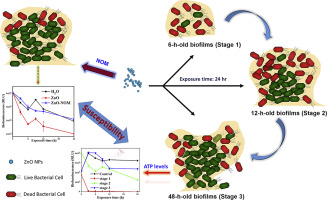当前位置:
X-MOL 学术
›
Environ. Pollut.
›
论文详情
Our official English website, www.x-mol.net, welcomes your
feedback! (Note: you will need to create a separate account there.)
Effects of humic acid on the interactions between zinc oxide nanoparticles and bacterial biofilms ☆
Environmental Pollution ( IF 7.6 ) Pub Date : 2017-08-26 , DOI: 10.1016/j.envpol.2017.07.003 Kai Ouyang , Xiao-Ying Yu , Yunlin Zhu , Chunhui Gao , Qiaoyun Huang , Peng Cai
Environmental Pollution ( IF 7.6 ) Pub Date : 2017-08-26 , DOI: 10.1016/j.envpol.2017.07.003 Kai Ouyang , Xiao-Ying Yu , Yunlin Zhu , Chunhui Gao , Qiaoyun Huang , Peng Cai

|
The effects of humic acid (HA) on interactions between ZnO nanoparticles (ZnO NPs) and Pseudomonas putida KT2440 biofilms at different maturity stages were investigated. Three stages of biofilm development were identified according to bacterial adenosine triphosphate (ATP) activity associated with biofilm development process. In the initial biofilm stage 1, the ATP content of bacteria was reduced by more than 90% when biofilms were exposed to ZnO NPs. However, in the mature biofilm stages 2 and 3, the ATP content was only slightly decreased. Biofilms at stage 3 exhibited less susceptibility to ZnO NPs than biofilms at stage 2. These results suggest that more mature biofilms have a significantly higher tolerance to ZnO NPs compared to young biofilms. In addition, biofilms with intact extracellular polymeric substances (EPS) showed higher tolerance to ZnO NPs than those without EPS, indicating that EPS play a key role in alleviating the toxic effects of ZnO NPs. In both pure ZnO NPs and ZnO-HA mixtures, dissolved Zn2+ originating from the NPs significantly contributed to the overall toxicity. The presence of HA dramatically decreased the toxicity of ZnO NPs due to the binding of Zn2+ on HA. The combined results from this work suggest that the biofilm maturity stages and environmental constituents (such as humic acid) are important factors to consider when evaluating potential risks of NPs to ecological systems.
中文翻译:

腐殖酸对氧化锌纳米颗粒与细菌生物膜相互作用的影响☆
腐殖酸(HA)对ZnO纳米颗粒(ZnO NPs)与恶臭假单胞菌之间相互作用的影响研究了不同成熟阶段的KT2440生物膜。根据与生物膜形成过程相关的细菌三磷酸腺苷(ATP)活性,确定了生物膜形成的三个阶段。在最初的生物膜阶段1中,当生物膜暴露于ZnO NP时,细菌的ATP含量降低了90%以上。但是,在成熟的生物膜阶段2和3中,ATP含量仅略有下降。与第2阶段的生物膜相比,第3阶段的生物膜对ZnO NPs的敏感性更低。这些结果表明,与年轻的生物膜相比,更多成熟的生物膜对ZnO NPs的耐受性更高。此外,具有完整细胞外聚合物(EPS)的生物膜对ZnO NP的耐受性要高于不含EPS的生物膜,表明EPS在减轻ZnO NPs的毒性作用中起关键作用。在纯ZnO NP和ZnO-HA混合物中,溶解的Zn来自NP的2+明显促进了总体毒性。HA的存在由于Zn 2+在HA上的结合而大大降低了ZnO NPs的毒性。这项工作的综合结果表明,在评估NP对生态系统的潜在风险时,生物膜的成熟阶段和环境成分(例如腐殖酸)是要考虑的重要因素。
更新日期:2017-08-28
中文翻译:

腐殖酸对氧化锌纳米颗粒与细菌生物膜相互作用的影响☆
腐殖酸(HA)对ZnO纳米颗粒(ZnO NPs)与恶臭假单胞菌之间相互作用的影响研究了不同成熟阶段的KT2440生物膜。根据与生物膜形成过程相关的细菌三磷酸腺苷(ATP)活性,确定了生物膜形成的三个阶段。在最初的生物膜阶段1中,当生物膜暴露于ZnO NP时,细菌的ATP含量降低了90%以上。但是,在成熟的生物膜阶段2和3中,ATP含量仅略有下降。与第2阶段的生物膜相比,第3阶段的生物膜对ZnO NPs的敏感性更低。这些结果表明,与年轻的生物膜相比,更多成熟的生物膜对ZnO NPs的耐受性更高。此外,具有完整细胞外聚合物(EPS)的生物膜对ZnO NP的耐受性要高于不含EPS的生物膜,表明EPS在减轻ZnO NPs的毒性作用中起关键作用。在纯ZnO NP和ZnO-HA混合物中,溶解的Zn来自NP的2+明显促进了总体毒性。HA的存在由于Zn 2+在HA上的结合而大大降低了ZnO NPs的毒性。这项工作的综合结果表明,在评估NP对生态系统的潜在风险时,生物膜的成熟阶段和环境成分(例如腐殖酸)是要考虑的重要因素。











































 京公网安备 11010802027423号
京公网安备 11010802027423号